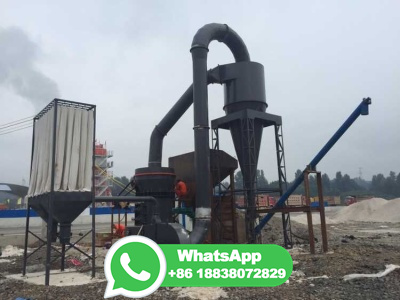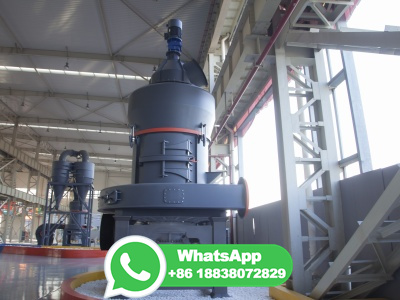
Abstract The iron ore production has significantly expanded in recent years, owing to increasing steel demands in developing countries. However, the content of iron in ore deposits has deteriorated and lowgrade iron ore has been processed. The fines resulting from the concentration process must be agglomerated for use in iron and steelmaking.
WhatsApp: +86 18838072829
A brief introduction to recent developments in iron ore pelletizing is provided in this chapter, including the world output of fired pellets, pellet production processes, preparation of pellet feed, inorganic and organic binders, and new additives.
WhatsApp: +86 18838072829
The steps are; 1. calculation of DRI pellet enthalpies at 25°C and 930°C, the topsegmentbottomsegment division temperature; 2. specification that the DRI pellets are not oxidized nor reduced while descending through the top segment so that their mass and composition entering the bottom segment are the same as when they are top charged; and 3.
WhatsApp: +86 18838072829
In the magnetite iron ore pelletization process, oxidation of magnetite followed by sintering of the oxidized magnetite (hematite) is desirable. Optimum preheating time temperature and roasting time temperature is required to get the desired properties of the pellets with magnetite, hematite, and hematitemagnetite blend. In order to utilize the magnetite resources in a current ...
WhatsApp: +86 18838072829
Iron ore pellets are commonly used as iron burden materials in blast furnaces. The pellets are small and hard iron ore balls. Their diameter is usually 1016 mm. The pellets are hotbonded in order to provide sufficient mechanical strength. A high iron content and a low gangue content is favourable for blast furnace pellets . Additives are ...
WhatsApp: +86 18838072829
Recently, the grade of iron ore deposits has deteriorated and further development of low grade deposits is desired. Presently, the most effective and often followed route taken to utilize such deposits is the provision of beneficiation plants for upgrading iron ore and pelletizing plants for agglomerating. Kobe Steel has much experience
WhatsApp: +86 18838072829
At DRplants today, natural gas or syngas is used to reduce iron ore pellets into porous sponge iron. This process generates heat as the pellet is reduced. However, simple calculations show that by changing the natural gas into hydrogen, energy is consumed during the reduction process [4], [5]. The difference between the enthalpies for reducing ...
WhatsApp: +86 18838072829
Production of pellet as a desirable feedstock for ironmaking furnaces has exceeded 300 Mt per year in 2005, accounting for about 24% of the iron ore processed globally (UNCTAD, 2006). The production of iron ore pellets involves two major steps, forming the "green" pellets in rotary disks or drums, followed by their heat
WhatsApp: +86 18838072829
Pelletizing is an agglomeration process which converts very fine grained iron ore into balls of a certain diameter range (normally 8mm to 20 mm, also known as pellets. These pellets are suitable for blast furnace and direct reduction processes.
WhatsApp: +86 18838072829
At the plant scale, we demonstrate the capabilities of the model to investigate ... The shaft furnace (Figure2) is the core of the DR process. Iron ore pellets are charged at the top, descend due to gravity, and encounter an upward counterflow of gas. The reducing gas (CO and ... x The description of the pellet transformation: shrinking core ...
WhatsApp: +86 18838072829
The pressure of (1) A 3D model for the pellet cooling process in a cooler cooling air in the annular cooler varies from −4 to −130 Pa. has been developed, and a field test was systematically car The air flow velocity is higher on both sides than that in the Feng et al., Cooling process of iron ore pellets in an annular cooler 291 ...
WhatsApp: +86 18838072829
The shaft furnace operates using a counterflowing ore and reducing gas to produce a sponge iron product, requiring ore in pellet form with minimum 67% Fe content 21 to limit ore impurities and ...
WhatsApp: +86 18838072829
Most iron ore exported from Australia is in the form of haematite, however magnetite ore found at Whyalla, which is magnetic, is more suited to direct reduction processes using hydrogen. The demonstration plant is capable of taking ore from the company's mines to produce around million tonnes of 70 percent iron magnetite ore annually.
WhatsApp: +86 18838072829
Direct Reduced Iron (DRI) is the second most viable source of virgin iron used in steelmaking after pig iron or hot metal produced in blast furnaces. DRI is produced by direct reduction of iron ore using carbon monoxide and hydrogen. Natural gasbased shaft reactors are commonly used in North and
WhatsApp: +86 18838072829
Smart and automatic process adjustments to obtain pellets with required properties, increase the throughput and reduce energy consumption ... By their nature ore grinding, pellet drying and firing processes are very complex and have always been dependent on operator expertise. By combining plant models and operator experience with carefully ...
WhatsApp: +86 18838072829
Any pellet binder is subject to a handful of practical requirements: that it be readily dispersed through a pellet, that it effectively controls the movement of water within the pellet, and that it contributes to the interparticle bonding within the pellet.
WhatsApp: +86 18838072829
Iron ore is one of the two essential inputs for producing direct reduced iron (DRI); the other being natural gas or another hydrocarbon fuel that can be reformed to create a reducing gas rich in CO and H2. Although direct reduction processes can operate with pellets having an iron content of 65% or lower, typical of blast furnace (BF)grade ...
WhatsApp: +86 18838072829
M 1 25 Iron ore pellets Pellet heater M 2 800 Heated iron ore pellets Pellet heater M 3 500 H 2 entering the shaft furnace Shaft furnace
WhatsApp: +86 18838072829
A passion for pelletizing and consideration of the entire process chain from start to finish are fundamental to innovative pelletizingplant solutions. Rawmaterial testing, mathematical simulation, 3D planning, and process automation are key elements Primetals Technologies brings with its passion for innovation to the iron and steel industry.
WhatsApp: +86 18838072829
The roller screening process is an important step in the iron ore pellets production. This step is intrinsically linked to the balling production and the induration machine. Improvements to the equipment performance not only promotes benefits to the plant's productivity, but also in the final product's quality.
WhatsApp: +86 18838072829
The iron ore induration or pelletizing process emits particulates, sulfur dioxides (SOx), nitrogen oxides (NOx) and other pollutants depending on trace elements in the orebody and fuel. Typical emission levels for these compounds during induration will be outlined, and corresponding options for pollution control equipment described. Recent pellet plant construction in Sweden and the United ...
WhatsApp: +86 18838072829
43 Pellets produced to be used in ironmaking processes must have characteristics that meet the list of quality specifications regarding physical, chemical, and metallurgical properties. Almost...
WhatsApp: +86 18838072829
The plant used iron ore concentrate as input and produced superior iron ore pellets for blast furnace and direct reduced iron feed. Since then, GrateKiln Systems have been used for over 50
WhatsApp: +86 18838072829
Process description. The concentrate slurry is received at pellet plant and stored in slurry tanks [Figure 5]. The concentrate slurry is fed to the filtration process where it is dewatered by pressure filters. ... The main raw material for the pellet plant is iron ore, which comes as slurry from the beneficiation plant through the pipe line ...
WhatsApp: +86 18838072829
ClevelandCliffs recently completed a 100 million expansion at its Northshore Mining operation to support largescale commercial production of DRgrade pellets. With its completion, Northshore Mining is now the only based iron ore processing facility to produce low silica DRgrade pellets. The Northshore operation is producing DRgrade ...
WhatsApp: +86 18838072829
The iron ore pelletizing process consists of three main steps: Pelletizing feed preparation and mixing: the raw material (iron ore concentrate, additives —anthracite, dolomite —and binders are prepared in terms of particle size and chemical specifications, dosed, and mixed together to feed the pelletizing process;
WhatsApp: +86 18838072829
The plant took iron ore concentrate and produced superior iron ore pellets (which are spheres of high iron content and uniform quality) for blast furnace and direct reduced iron feed. Since then, GrateKiln systems have been used for over 50 plants, on both magnetite and hematite ores, with an installed capacity of over 115 million tpy.
WhatsApp: +86 18838072829
Iron ore pellets are small and hard spherical particles agglomerated from a fine iron ore concentrate. They are used in the blast furnace process to produce hot metal. The diameter of blast furnace pellets is usually between 8 and 16 mm. In this study, a batch of magnesia iron ore pellets was first sieved into particle sizes of 810 mm, mm, mm and 1620 mm, and the four ...
WhatsApp: +86 18838072829
7. Halt, JA, Silva, B, and Kawatra, SK, 2015. 'A new on line method for predicting iron ore pellet quality', Mineral Processing and Extractive Metallurgy Review, 36(6):377384. 8. Halt, JA and Kawatra, SK, 2015. 'Iron ore pellet dustiness Part II: Effects of firing route and abrasion resistance on fines and dust generation.'
WhatsApp: +86 18838072829